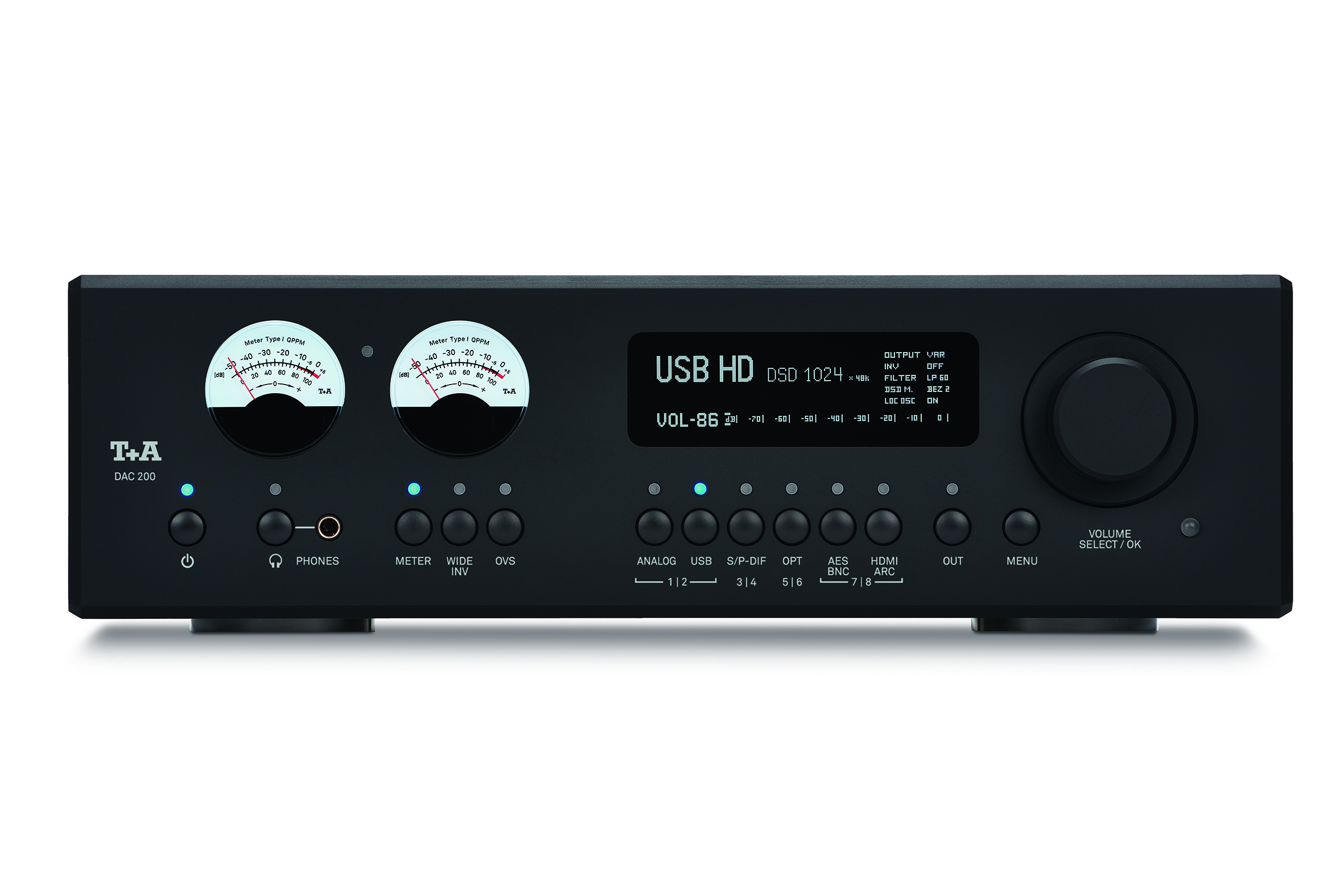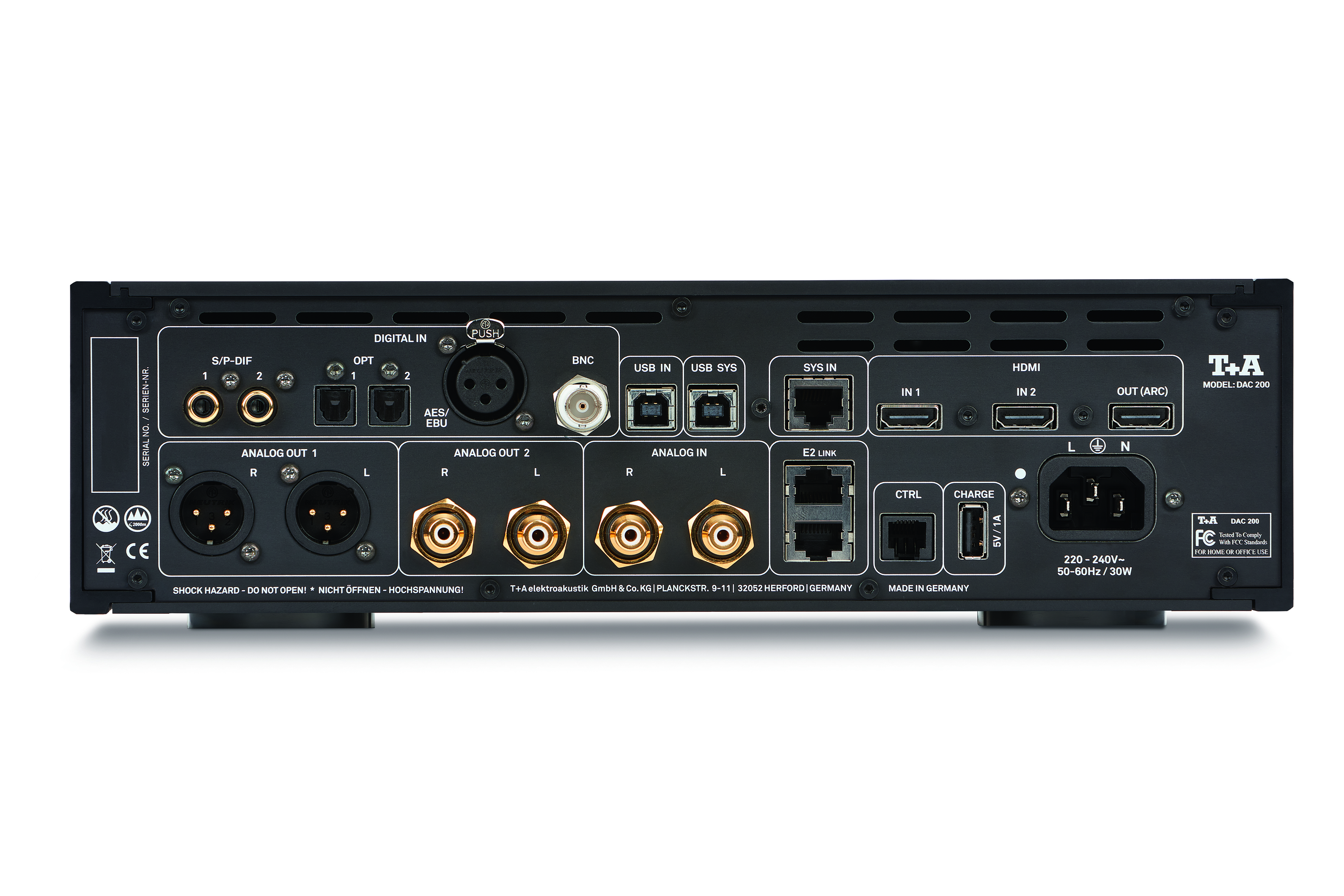T+A A Extraordinary DAC 200 aside from all format, amazing musicality, also a preamp.
At True Audiophile.
T+A DAC 200. One of the finest DAC's we've ever heard. Yes, really..and by the day more and more reviewers are discovering that fact --Mini Review by True Audiophile
From our Reviewer:
"This is an absolutely stunning DAC with the best sound quality I have heard in my system, period. I find myself looking up every now and then to check why an instrument or voice sounds so real. The overall sound is expansive and hugely dynamic. The dynamic shadings large and small plus the 3 dimensional definition of space puts this DAC in a higher plane than I am accustomed to.
The build quality is beautiful, slightly industrial and reminds me a bit of Nagra gear. This is certainly not a cheap DAC, but when I consider that it is also a very fine preamp, a streamer and that it can play every conceivable format, it becomes a great value."
We can order anything in the T+A line. Just send us an email.
Available for DEMO if you live in or near the Portland area.
The Absolute Sound says:
"Each individual component is an unqualified success with top-flight sound and undeniable musicality. Meanwhile, the fully loaded stack can go toe to toe with the best modular integrateds at a fraction of their cost. If you’re in the market for a component or a component stack that delivers superb sonics, musicality, value, achingly good looks, and the advantages of separates, along with a small footprint, the Series 200 will remind you that good, even great things really do come in small packages". Read full Review Here
Computer Audiophile - 5 Stars
Conclusion
Audiophile Suggested Hardware Award
Many years from now, when T+A ceases DAC 200 production, this DAC will have an immediate cult following, and values on the used market will shoot up. This is one of those DACs that'll be sought after for decades. It does so much, so right. It's a product for which the CASH List was created. The DAC 200 is among the leaders, at any price, on our list of recommended hardware, and easily the leader among its peers anywhere near its $7,125 MSRP.
This DAC was designed to use its internal filters or take advantage of the great horsepower of an external upsampling computer running HQPlayer. Either way, the T+A DAC 200 delivers the goods. It's a 10 out of 10 on its own, and an 11 out of 10 with the world class DSP from Jussi Laako's HQPlayer.
After listening through the DAC 200 for a few weeks, using it with different sources, reading the user manual a couple times, and exchanging emails with the T+A team, I realized that T+A gets it. I'm willing to bet that many readers will immediately understand what "it" is, because they've also been immersed in this world of digital audio for many years and tried many different solutions in an effort to perfect their audio systems. T+A enables many of us to have the best of both worlds because the company gets it on so many levels, embraces cutting edge technologies, and has set a new standard for digital to analog conversion at a competitive price.
Well done T+A, well done.
Read Full Review here.
Hi-Fi News Verdict
While avoiding any lame jokes about 'German engineering', I'm bound to say there's a wonderful sense of synergy – and not just in build and style – between these two T+A components. The A 200 is a mature-sounding power amp with excellent driving ability, and a perfect partner for the DAC 200's refined, insightful and light-footed approach...Read full review here.
The DAC 200 is the latest member of an extended family of High-End converters and pre-amplifiers. Every aspect of its design symbolises T+A's uncompromising commitment to science and music. The ability to reproduce DSD 1024 files and its complete galvanic separation are just two highlights which underline the potential of the DAC 200 in impressive style. The DAC 200 is designed to convert a large number of digital formats into natural-sounding analogue signals, and to pass them on via the integral headphone or analogue outputs.
T+A's belief in totally pure music required an enormous effort on T+A's part to eliminate the most minuscule of interfering influences. The T+A De-Jitter Masterclock was developed with the goal of freeing all T+A DACs from such interference signals, and in particular those which result from the use of computers. This type of interference – known as jitter – is caused by minimal timing errors, which still manage to exert a harmful influence on the sound experience unless they are removed before the conversion into analogue signals.
The De-Jitter Masterclock was developed here in Herford, and constitutes a consistent audiophile response to jitter: in a multi-stage process the incoming signals are examined, and even the largest of jitter artefacts are removed. In the first stage the incoming signal delivers a raw clock pulse which is analysed very closely by micro-processors: the signal is then switched to the Masterclock – but only if its frequency and stability fulfil strict minimum criteria. If those criteria are not met, the signals are cleaned again through a further PLL stage in a specially constructed second jitterbug; this process reduces the residual jitter by a factor of 4.
Signals which fulfil the purity requirements are de-coupled completely from the input jitter by switching to the Masterclock. They are then further processed by two high-precision quartz oscillators. Each oscillator is reserved for a single clock family; the Masterclock covers both the odd 44.1 kHz clock to 354.8 kHz as well as the even 48 kHz clock to 762 kHz.
T+A believes in reproducing music in its purest form. And that is why T+A makes every effort right at the development stage to eliminate even the most insignificant of interference factors, regardless of how minimal they are. Joint processing of PCM and DSD files in a single converter is just such a source of interference: supposedly insignificant, but in fact having a crucial influence on the sound. It was T+A's insistence on eliminating this particular influence that caused us to develop the unique T+A Path Separation Technology: both PCM and DSD have their own converter, specifically tailored to their requirements. These converters exclude adverse sound influences as well as exploiting the potential of each format to the full. For PCM signals T+A's use T+A's quadruple converter, whereas DSD files are processed using the T+A True 1-bit converter, which is unique in the world.
T+A True 1-bit converter is unique, as it forms a break with a paradigm: conventional converters process DSD signals by converting them into PCM, and reproducing them using the PCM mode. But this conversion contradicts T+A's principles, and caused us to develop the True 1-bit converter, which processes DSD files in their native form, without detrimental conversion processes, and reproduces them in totally pure form as genuine 1 Bit Stream.
T+A's PCM Quadruple Converter features a double symmetrical circuit design comprising the eight 32-bit Burr-Brown converters, thereby providing above-average compensation for non-linearities in the sound, and reduces the already minimal background noise by a further 6 dB. This sophistication results in amazing dynamism and linearity combined with an equally amazing freedom from distortion. Although T+A believe in unadulterated music reproduction, the Bezier filters – another in-house development – in the quadruple converter can be exploited by the listener to fine-tune the sound characteristics to his individual taste. The application of polynomials results in perfect timing behaviour for each of the six available filters, two of which are NOS stages.
The analogue sound quality is crucially determined by consistent separation between the digital and analogue sections. This separation, which T+A's term the “Digital Analogue Separation System”, utilizes ultra-fast digital isolators from Silicon Labs to provide galvanic separation between the analogue and digital sections. Since it is vital to maintain this separation through the entire signal chain, the mains sections for the analogue and digital signal paths are also completely separated galvanically.
No restrictions of any kind – this maxim was T+A's guide in determining the DAC 200’s connections: its inputs are as universal as they are high in quality: the USB-B inputs are based on the new high-resolution Thesycon chip, which processes signals up to DSD 1024. AES/EBU and BNC are also present, as is SP/DIF in optical and coaxial forms. The T+A SYS Link completes the high-speed signal connection within the Series 200 via the SYS IN input. One analog input is installed as standard, but two stereo HDMI inputs are available as an option.
As a specialised pre-amplifier, the DAC 200 features a discreet Class A pre-amplifier section as well as double mono “State of the Art” outputstage, whilst also providing several outputs designed to cope with any requirement. Balanced XLR and unbalanced RCA outputs transfer the analogue signals to the output stages, while headphones are connected via a balanced 4.4mm Pentaconn headphone output, which draws its signal from a special high-performance headphone amplifier. In contrast to conventional chip solutions, this is of fully discreet construction, and is specially designed for the requirements of headphones. An HDMI output with Audio Return Channel (ARC) for HDMI signal pass-through is available on the optional HDMI board.
Here's a direct link to our unboxing video
Here's a direct link to a very in-depth video on the DAC 200
[[[specification_start]]]
Analogue section
High level (RCA) 0...2,5 Veff / 22 Ohms, balanced (XLR) 0...5,0 Veff / 22 Ohms
fixed:
High level (RCA) 2,5 Veff / 22 Ohms, balanced (XLR) 5,0 Veff / 22 Ohms
discreetly designed Class A-HV-output stage in Double-Mono-Circuitry
Analogue inputs
Digital inputs
supports asynchronous data transfer. *DSD 512 and DSD 1024 with Windows PC and appropriate driver installed or Linux PC with Kernel 4.4 or higher only.
Supports DoP up to DSD 256 (0x05/0xFA Marker).
D/A converter per channel, 705,6 / 768 kSps conversion rate
[[[specification_end]]]







